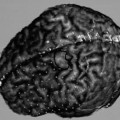
Cerebrovascular Applications of Image-Guided Surgery
The majority of treatments for patients with cerebrovascular disease involve modern neuroimaging techniques. The term image guidance therefore has broad applications in the fields of cerebrovascular neurology and neurosurgery. The cerebrovascular applications of image guidance can be separated into four different categories. These include pretreatment evaluation and planning, surgical rehearsal, lesion localization, and intraoperative navigation.
This chapter focuses on selected conditions for which neurosurgical or endovascular treatments are being considered. These include intracranial aneurysms, cranial base lesions, cavernous angiomas, and arteriovenous malformations.
 Pretreatment Evaluation of Intracranial Aneurysms
Pretreatment Evaluation of Intracranial Aneurysms
Radiological studies used in evaluating intracranial aneurysms include “invasive” studies: catheter cerebral angiography, rotational three-dimensional catheter angiography (3-DA), and “noninvasive” studies: computed tomographic angiography (CTA), magnetic resonance imaging (MRI), and magnetic resonance angiography (MRA).
Catheter cerebral angiography and 3-DA provide superior resolution of small vascular structures. Catheter cerebral angiography remains the gold standard for detection of intracranial aneurysms and is the study of choice for this purpose, whereas 3-DA provides detailed anatomical information about aneurysm morphology and the relationships between the lesion and adjacent normal vasculature. The level of detail that can be achieved by catheter cerebral angiography and 3-DA remains unrivaled by the noninvasive methods. However, catheter cerebral angiography also has disadvantages. The majority of patients find that despite all precautions the procedure is painful and uncomfortable. Many describe postprocedural pain at the femoral artery puncture site. Although serious complications are rare, catheter cerebral angiography is associated with a neurological complication rate of as much as 2.0%, leading to persistent neurological deficits in 0.07 to 0.8%, and nonneurological complications in 14.7% of patients.1–3 The longer injection of intra-arterial contrast required by 3-DA adds additional discomfort and may therefore require heavy sedation that is frequently not tolerated by sensitive patients.
A number of investigators have recently reported on the considerable utility of 3-D reconstruction of CT, MR, and angiographic data for preoperative evaluation of patients with cerebrovascular disease.1,4–24
Case 1: Pretreatment evaluation of a posterior communicating artery aneurysm
Rationale
Surgical planning can be facilitated by visualizing the craniotomy necessary to expose the aneurysm. This is particularly valuable for residents and students who are less familiar with the surgical anatomy. In addition it may be helpful to understand the anticipated degree of proximal control, and the vicinity of the aneurysm to the anterior clinoid process.
Case description
A 58-year-old female was evaluated for a new left third nerve paresis, and a left posterior communicating artery aneurysm was discovered (Fig. 14–1A). Preoperative CTA with 3-D reconstruction of the volume-rendered surface was manipulated to simulate the pterional craniotomy required to expose the aneurysm. The preoperative simulation in Figure 14–1B and C predicted the appearance of the aneurysm and adjacent structures found at surgery, and facilitated uneventful clipping (Figs. 14–1D and 14–1E).
Discussion
Preoperative simulation of the craniotomy is a useful tool for teaching neurosurgical residents and students. It can be helpful to surgeons in predicting the relevant surgical anatomy such as the degree of proximal control, the proximity of the anterior clinoid process, and the like.
Limitations
Important soft-tissue structures such as the dura of the tentorial edge, the optic and occulomotor nerves, and brain parenchyma are not visualized on the preoperative CTA. Estimating the amount of proximal internal carotid artery (ICA) control with the pterional exposure must take this into account.
Case 2: Pretreatment evaluation of a middle cerebral artery aneurysm
Deciding whether to clip or coil an intracranial aneurysm depends on several anatomical and clinical factors. In patients whose clinical status supports both treatment options the decision is based primarily on anatomical features such as the size, shape, and location of the aneurysm; its relation to surrounding anatomical structures; and the precise configuration of the parent and perforating vessels. For middle cerebral artery (MCA) aneurysms, long-term success rates for coiling are highest for small aneurysms with small necks, and lowest for large aneurysms with large necks. It is important to know the relationship of the aneurysm neck to the M1 and M2 segments, and for clipping, it is helpful to visualize the structures in relationship to the planned craniotomy.
Case description
A 50-year-old female was evaluated for an intracranial aneurysm discovered on MRI done to evaluate left-sided headaches. Catheter angiography revealed three aneurysms of the left MCA: a small lenticulostriate aneurysm, an anterior temporal artery aneurysm, and a large multilobulated MCA trifurcation aneurysm (Fig. 14–2A). Preoperative CTA with 3-D reconstruction and surface rendering defined the anatomy of the three aneurysms (Fig. 14–2B) and their relation to a standard pterional opening (Fig. 14–2C). The preoperative simulation in Figure 14–2C closely predicted the appearance of the aneurysm and related vasculature that was found at surgery (Fig. 14–2D) and facilitated uneventful clipping (Fig. 14–2E).
Discussion
In this case preoperative noninvasive imaging with 3-D reconstruction provided additional information about the anatomy of the aneurysms and their relationship to adjacent vascular and bony structures. Preoperative simulation gave an excellent estimation of the surgical appearance. However, limitations in the resolution of CTA using singleslice CT scanners mean that important vessels that are visible on catheter angiograms and at surgery, such as the anterior temporal artery, are not seen on the CTA. This limitation must be considered during surgical planning.
Case 3: Pretreatment evaluation of a paraclinoid aneurysm
Case description
A 27-year-old female was found to have a right paraclinoid aneurysm, demonstrated with a carotid angiogram (Fig. 14–3A). Preoperative CTA with 3-D reconstruction and surface rendering defined the anatomy of the aneurysm and its relation to the anterior clinoid process (Fig. 14–3B). The CTA predicted that only minimal drilling of the anterior clinoid would be required for exposure and proximal control. The preoperative simulation in Figure 14–3B closely predicted the appearance of the aneurysm and related vasculature that was found at surgery (Fig. 14–3C) and facilitated uneventful clipping (Fig. 14–3D).
Discussion
In this case preoperative imaging gave a good indication of how much drilling would be required for proximal control. Key features of the surgical anatomy (e.g., the optic nerve and the dura covering the clinoid process) were not visualized preoperatively.
Case 4: Pretreatment evaluation of a paraclinoid aneurysm
Case description
A 47-year-old female was evaluated for an intracranial aneurysm discovered on MRI done to evaluate left retroorbital pain. Catheter angiography demonstrated a broad-based carotid-ophthalmic aneurysm projecting superiorly (Fig. 14–4A). Preoperative CTA with 3-D reconstruction and surface rendering defined the relationship of the aneurysm to the distal internal carotid artery and the anterior clinoid process (Figs. 14–4B and 14–4C
Stay updated, free articles. Join our Telegram channel

Full access? Get Clinical Tree




